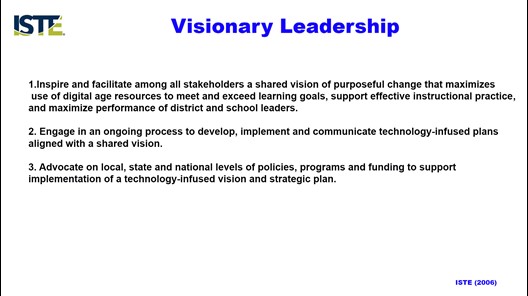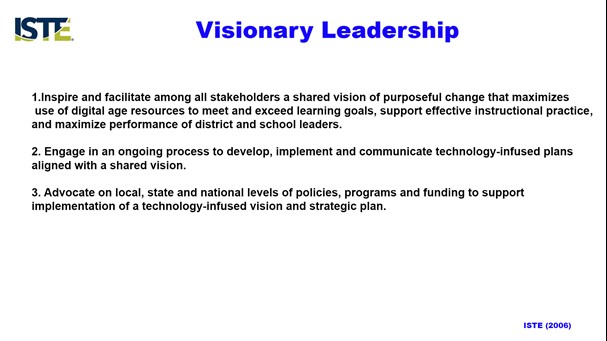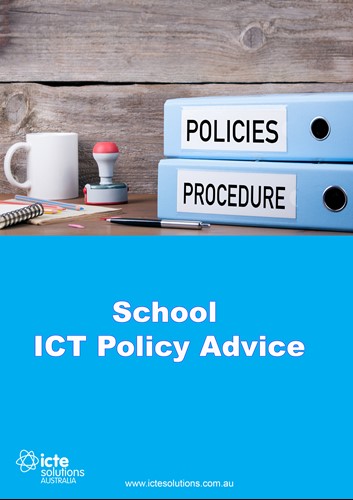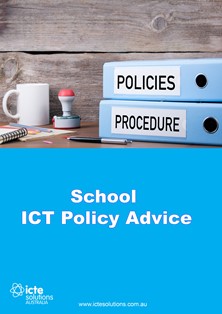One of the most common products of developing your school’s strategic plan in ICT is its vision in ICT. This is not in terms of resources or assets, but in terms of measurable benefits over a 5-10 year period. The school’s vision in ICT might be summarised in a ‘vision statement’ which is written out in general terms and which should be owned by all staff members.
Vision statements for schools is a good way to begin writing your ICT policy for the school. It is a public declaration of the values of the school and is central to its ICT planning. Technology vision statements for education is what is needed to drive change in the classroom so that children can be equipped with the knowledge, skills and understanding required for an online and digital world.
What are the benefits of a school Vision statement?
The benefits of an effective school vision statement are that it will support and enhance the school’s aims in terms of teaching and learning, and management and administration.
They are reliable representations of what schools stand for and requires discussions about:
- School priorities;
- Principles, aims, and goals related to student learning progression in ICT capability and;
- Overall and specific expectations associated with any shift or change in the direction of technology integration in schools.
In some countries like the United States, the vision statement is established by the school district. Where this occurs schools are required to develop a pertinent vision statement.

Sharing perspectives in ICT Integration
Your strategic plan may be in place, however, without a shared vision for ICT integration there will be no spark to ignite the change. Educational leaders such as yourself, whether you are a principal, ICT coordinator, or a learning technologies coordinator, are the spark that should ignite this shared vision for how technology will be integrated into the school in a comprehensive way.
As a digital leader, it is your role to guide the evolution and realisation of a vision that can support transformation at your school.
To develop a shared vision in ICT integration you could:
- Show videos of students and teachers working with technology in the classroom.
- Show videos of students talking about digital-age learners and how important accessing information and technology is to them.
The following example of an ICT vision statement will put this into perspective for you.

Example of a Vision Statement for Schools in ICT Capability
As part of your school ICT policy, you will need to ensure that your technology vision statement is related to how ICT will be used and ICT capability developed, in the teaching of all subjects.
Here is a school vision example:
“ICT will be used effectively to raise awareness of the benefits and uses of technology, to enhance learning and teaching in all subjects, to improve school management and administration processes, to promote home-school links, and overall, to improve the attainment of all students.”
(Hall, 2010, p. 160)
This represents a school vision statement in ICT integration.
Do you know the ICT vision of your school?
Your school ICT Policy is a document that demonstrates your school's intentions. Back up your vision with an effective mission for the school and begin the school's journey to ICT greatness today.
How Educational Leaders can become Technology Visionaries?
Educational leadership vision plays a key role in transformational change. However, change within the classroom is never easy. ICT integration is not a straightforward process and it requires educational leadership vision that will drive its implementation and make an impact on student learning.
This is what effective educational leadership in ICT is all about. The vision statement that you and the other members of the committee have set for the school should form the foundation of this visionary in education. As an educational leader in ICT, it should ground your perspectives and values in the use of ICT integration.
If you are a technology visionary in education, then this is how you can gain further expertise in order to point your colleagues towards the right strategies for technology in the classroom.
LEARN ABOUT:
Communicating effectively as a school technology visionary
3 Ways to develop your vision statements for schools
Visionary leadership in education needs to be coherent if the seeds of change are to germinate. Educational leadership and technology integration also need to ensure that student ICT capability is achieved and sustained.
In 2006, ISTE released its standards for administrators which highlighted just exactly you can achieve a shared vision. Having a shared vision of what it means to integrate ICT and be ICT capable is what also what was emphasised in Kennewell’s (2000) studies on ICT capable schools. He stated that the “process of developing ICT capability can never be complete” (p. 16).


Being a true visionary is about having a definite idea of what should take place with technology solutions for the classroom. These technology solutions must be about the here and the now of the available technologies and not about the next big technological development that you hope will solve your ICT problems. For this to occur, it requires you to have a thorough understanding of the current environment. Gather the data you need to support your quest for ICT greatness at the school.
ICT capability can only be achieved if students use ICT tools and resources in purposeful activities of meaning context. This should be included as part of your vision.
Failing to have a shared vision in what it means to integrate ICT and be ICT capable could result in a series of “good enough” decisions that would merely just satisfy the present needs without planning successfully for the future. This is not effective educational leadership in ICT. Educational leaders that will neglect to involve staff in the vision will not achieve a coherent vision of ICT integration throughout the school.
As more schools invest in ICTs for their students and staff, this could be a fatal mistake as schools that do this become stronger in their economic competitiveness and this could leave all make them a threat to your school’s success.
Your vision should include (Grady, 2011, p. 17):
- The leadership the principal exerts on ICT integration into the teaching and learning process;
- The role of teachers in integration of ICT into teaching and learning activities;
- The standards that will guide the ICT plan for the school;
- The measures that will be applied to assess ICT use;
- The resources that are necessary to enable effective use of ICT by students and teachers and;
- The communication with families and community members to showcase the use of ICT to facilitate student learning and achievement.
Having not a vision but a shared vision of ICT integration and what it means to be ICT capable is tough. Even harder is being able to manage to this vision. However, it is possible. It may take years until you know whether the ICT the school invested in was the right one.
To be a good visionary in ICT in education, you need to be smart and fearless. You also need to have a strong opinion today about where the world is headed and then, make the appropriate decisions and choices to the point where you will be able to determine if they were a success or failure.
Educational Leadership Resources at Teachers Pay Teachers

Two other qualities of visionary leadership in education would include:
Community builder – this is part of what I was discussing earlier. An educational leader who is a community builder knows that they cannot implement the school’s vision in ICT alone. There is an understanding that high-functioning teams are essential, and that a healthy community will contribute to retention, stability, and investment.
Emotional intelligence – this is the ability to understand and manage other’s emotions as well as your own. They are calm, grounded, and empathetic. This enables them to take care of themselves and to manage stress, health, and relationships well.
Effective educational leadership in ICT is about ensuring that the school’s vision is achieved and sustained. It is about you as the educational leader promoting the use of technology in the classroom and leading by example in front of your colleagues and staff.
Join other educational leaders in our educational leadership professional development online today. Along with gaining additional expertise in ICT leadership, you will have access to our educational resources for free. Build your capacity in educational leadership and technology integration now.

The Change Equation
Promoting a lasting change in the classroom is difficult when many teachers are reluctant to shift from their tried and tested methods. However, must occur and this why effective visionary leadership in education must prevail in even the most disadvantaged schools where technology integration in the classroom can begin with a single computer.
Visionary leadership in education plays a key role in the change equation:
Dissatisfaction with the current situation x a shared vision of the future x knowing the first steps > resistance to change
As you can see, your vision of where ICT fits into the school curriculum takes part in establishing a secure place for ICT at your school.
What can you do?
You need to know where you want to go and unite the team behind your vision. It would also be beneficial for you to create in the minds of the people whom you work with the need for this change to occur. Good visionary leadership in education is about valuing teachers and their professional growth by sharing your vision with them and leading the change at your school.
It is essential that you establish a vision and implement a strategic process that promotes a lasting change in teaching and learning with ICT culture that provides students with essential capabilities in ICT. The change equation has indicated also the path to resistance, so ensure that they are all placed on the table. Any fears and misconceptions need to be aired out so that you can begin to establish your vision for ICT integration in the classroom and improve the numeracy facets of your visionary leadership in education.

Understanding Vision
To advance in the 21st century, schools need visionary leadership that have a clear and understood ideal. Those that do set and gauge efforts by their teachers to achieve this vision. It is a way for the school to reconnect to an increasingly alienated public.
Earlier, I discussed the importance of visionary leadership in education in terms of improving the attainment levels of ICT capability and technological literacy. In this article, I will delve into this more in terms of what you need to do be more effective in your role as an educational leader at your school.
So what is a visionary leader in education? They are people who:
- Able to change the character of their schools and gain reputations as outstanding leaders;
- Are recognised as successful because they lead schools with a sense of purpose and dedication and;
- Act to attain their ideas.
They are what I discussed earlier, they are highly motivated to be effective in their roles. Additionally, these people share their vision and support their staff to make it happen. These are the qualities of an effective visionary leader in education.
How do visions develop?
It is the belief that visions develop as a result of articulating a statement of beliefs and then implementing it. Other studies have opposed this and have suggested that vision is more of an evolutionary process (Education World). As a result, they require continuous reflection, action and re-evaluation.
For your vision to become a reality, both talk and action are necessary. There have been instances where schools have failed in their vision as a consequence of too little discussion. No matter how experienced the staff may be, without examining the vision and interpreting the same way there will be faults in the school’s plan.
How Educational Leaders can become visionaries?
There are many reasons why visionary leadership in education is imperative a 21st century ICT-integrated society. Many of these I have discussed above. However, it is just as important to create connections to your staff if you are to support the vision that you have for the school.
“The most important judgement about the worth of your school will be the changes it brings about its pupils over time. These may be viewed in terms of attitudes, behaviour, respect for elders and property, but mostly by the knowledge and learning children have gained.” (Harrison)
This leadership course for teachers and educational leaders guides participants through the process of vision and mission statements. Participants learn how to involve their staff in bringing meaningful change to their school by ensuring that everyone plays a key role in developing the vision and mission statement.
Your teachers are one of the key stakeholders of the ICT policy so it is important that they have a sense of ownership in its development. Therefore, all staff should clearly be involved in the discussion leading to the production of a new ICT policy.
How do you facilitate your vision?
Having a shared vision is one thing, however, you remain the key player to expedite the entire process.
“Do not assume that by arranging full staff meetings whereby an ICT policy will be produced onto a blank sheet of paper will be effective. Nor will writing and presenting a policy as a fait accompli will not have the support of many staff.”
It is also essential that you institutionalise the vision because no matter how inspiring it may sound on paper, the vision or dream will die unless it takes concrete forms in your school ICT policy.
You need to remain focused also on what the vision mission means in classroom terms because it will be your staff who will be carrying out the vision in practice and they require all the support that you can muster for them.
So what are you waiting for? Build on your visionary leadership in education today and learn more about our ICT Leadership course for Teachers now.


How Educational Leaders can Inspire Change in Classrooms today
Change is an interest in the human experience. It is well-known that attitudes to it can be self-perpetuating. For many teachers or people in general, change is not easy to accept. However, teachers live and teach in a changing society. Education itself closely linked to change as it exists just like teachers in a world of change. This means that it is essential that it has to prepare its students for a life of change.
So educational changes are vital if you as the ICT leader of your school are to ensure that you promote a lasting change particularly as technology is constantly changing. If your aim is to maximise student learning through the integration and implementation of digital technologies throughout the curriculum, then the educational leadership skills found in this educational leadership course and below to be of much value to your professional learning.
First, it is important to define a few things like ‘what is educational leadership’ and ‘why is educational leadership important’?
Educational leaders create a vision for the school and guide its staff and its community towards that vision. They ensure academic success through the process, material, and training improvements. Effective leadership in schools is achieved in relation to the integration of digital technologies:
- Developing the vision together with the whole staff;
- Communicating effectively and supportively about the importance of technology integration;
- Leading by example and carrying the banner for technology integration at the school;
- Support technology integration;
- Provide professional development opportunities for teachers using technology in the classroom and;
- Secure resources to support technology use and integration.
These are the reasons why ICT leadership in education is important. In the early childhood and primary education sector, it is of increasing significance as the two combined are responsible for the foundations of learning progression in child ICT capability. ICT leaders, whether it will be the principal, the ICT coordinator or the learning technologies leaders, are responsible for promoting this lasting change.
Secondly, you need to understand the basis for change as a leader in education. At least two entities are involved in the change process – the individual and the group. Change happens for individuals when they encounter information that conflicts with their existing knowledge base. Groups encounter change as a result of disequilibrium or conflict with other groups and this can occur on a cultural level, technological level, or socio-economic level for example.
If you are one these people then you would do well to consider what is commonly described as the change equation:
- You could perhaps try the following to overcome such issues:
- Exploit teachers’ dissatisfaction with what they are doing at present.
- Attempt to create an image of what advantages to children and teachers the prosed change will mean.
- Convey some idea as to the steps that will need to be taken.
Time is certainly an issue when it comes to change. School leadership and management in relation to ICT needs to understand that today teachers are working harder than before. For change to be successful and sustainable, teachers need time to understand ICT and integrate ICT into their practice. It also needs:
A prudent focus on a manageable number of priorities rather than scattered attempts to change everything and;
To be supported by sufficient resources, high quality learning materials and PD for teachers using technology in the classroom.
(Hargreaves, 2003)
Time is a key problem for all teachers and there are very few teachers who will concede that they have enough during their workday. Any sort of change will place demands on their existing commitments and educational leadership needs to demonstrate patience and perseverance in “understanding what the change requires, working clumsily and less competently through the change’s first faltering steps and learning how to integrate the changes into existing routines so that they become as effortless as possible in their job” Hargreaves (2003, p.105). The teachers under your leadership in schools are not only the casualties but the catalyst of change and so leadership in education must adhere to these attributes.

Technology and Change
As discussed briefly earlier, technology plays a strong role in educational changes. There are five stages of change that depend on individual characteristics and innovation characteristics and are comprised of the following (Rogers, 1962 as cited in ICI Global):
- Awareness.
- Interest
- Evaluation
- Implementation.
- Adoption.
In each of these stages, the educational leadership roles and that of teachers themselves include:
- Awareness – at this point there is no knowledge of a situation and educational leadership and management need to let staff know that something is happening. This will involve getting their attention one way or another.
- Information (receiving) – teachers begin to receive the information but don’t give any feedback. Educational leaders start by giving objective information through documents or presentations.
- Personal (responding) – teachers begin to react and communication is two-way. Educational leaders can optimise learning at this stage by showing the immediate benefits of the new information to the learner. Teachers need to know that support is available.
- Management – teachers try to fit information into their practice. It is better if they are supported in their practices by an instructor so that it will more likely that they will value that information and take intellectual risks.
- Consequence (valuing) – teachers may begin to question their return on investment. Educational leaders need to applaud this critical analysis and suggest alternative strategies.
- Collaboration (organisation) – teachers want to optimise new information integration at this stage and educational leaders should encourage them to support each other and share best practices through establishing networks that foster communities of practice.
- Re-focus – teachers become pro-active who work to sustain and institutionalise change for the entire organisation.
Such principles of educational leadership and management serves as a means for the effective integration of digital technologies in key learning areas.
For change to occur, there also needs strong leadership in teaching and learning too. Teachers themselves, who are not only the casualties but the catalyst of change in schools need to carry the mantel of practicing effective technology integration in the classroom.

Modelling Change
The leadership of change in schools must not come from both educational leaders and from the teachers. However, change must modelled by educational leadership and management.
As an educational leader, you need to promote technology in the classroom and you can do this in a number of ways:
- Focus on system improvement, where you provide leadership as a means to increase organisation through the use of digital technologies in the school.
- Put an emphasis on a purposeful change to ensure the achievement of the digital technology learning goals that you establish.
- With other educational leadership and management, collaborate to collect and analyse data that may increase both staff performance and student learning.
- Recruit personnel who are highly competent in implementing and using digital technologies and whose involvement will facilitate the attainment of learning goals.
- Consolidate partnerships to ensure that supports necessary to achieve systemic improvement overall.
- Develop and maintain an infrastructure that is supportive of teaching and learning with digital technologies.
(Hughes and Burke, 2014, p.92)
In this educational leadership professional development, we take this further in ensuring that you gain further expertise to achieve and sustain ICT capability when your staff integrates technology in the classroom. The educational leadership development that you will experience will ensure you lead purposeful change at your school.
If you are in leadership and education, here is what you can do according to Kennewell (2000):
- Ensure that financial support is available to update and maintain the equipment on a rolling program;
- Use ICT in your own administration and occasional teaching;
- Encourage teachers to attend all online professional development courses for teachers to enhance their own ICT capability;
- Work with small groups or individuals within the school system so that they are able to build the momentum and involve others in the process of change;
- Be involved in the practice of reflective and critical thinking about the culture and organisation of their schools, and about the ways in which this culture may need to change;
- Consider how the imposition of change can lead to low morale, dissatisfaction and reduced commitment by individuals within the school system;
- Win over the hearts and minds of teachers to the extent that they feel in control and have ownership of the new order;
- Demonstrate effective personal use of ICT and classroom organisation for student’s use of ICT;
- Be positive about integrating ICT rather than relinquishing responsibility to the ICT coordinator;
- Be enthusiastic in developing ICT capability in the curriculum and worked closely with the ICT coordinator to check the extent to which the agreed policy and schemes were being implemented in various departments;
- Recognise the need to pursue many other initiatives and plan to involve additional help in the monitoring process;
- Adopt an approach that involves some type of collaborative management to maximise the skills, commitment and energy of your staff to create a ‘potent and catalytic mix for successful change and development;
- Allow adequate time and resources but have deadlines and clear targets as well as the support required to achieve them.

What are the 12 attributes of an Early Childhood digital leader today?
The productive process of technology integration in early childhood education can be started by a strong-minded early childhood leader with just one single programmable toy or one digital camera and an ordinary computer.
Early childhood leadership in this digital age also requires dedication and judging that you are reading this means that this is where you are today.
It stands that you might already have established a direction in relation to technology integration and been able to influence others to sustain change. All of these is what literature highlights is necessary for someone like yourself.
However, there are many other attributes and below is a list that might be useful in helping you to boost your capacity as an early childhood leader in this digital age.
Compare your own knowledge and skills to determine if you have the dynamic mindset required to enhance early childhood learning activities with digital technology.
- A vision for the use of digital technology and media in the educational setting.
- An understanding that a robust infrastructure with connectivity, capacity and well-maintained devices is important to realising the vision.
- An ongoing plan for technology use, sustainability and improvement.
- Knowledge of the appropriate use of digital technology and media and how to integrate technology into new pedagogies and curriculum.
- An understanding of the digital divide and strategies to counter this.
- Appreciation of knowledge management and the value of combining technical and human resources.
- Distributed early childhood leadership styles that empower and invigorate others.
- High levels of interpersonal skills in a networked world.
- Modelling the use of digital technology and media.
- Developing a culture of trust, innovation and collaboration.
- Analytical skills so that the soundness of digital technology and media is critiqued.
- Capacity-building skills to support staff, students and families learning and using digital technology and media in a safe and supportive environment.
Being digitally wise as an early childhood leader is about being “conscious of the capabilities of existing technologies and look for opportunities to investigate the positives and negatives and strike a balance” (Stamopoulos & Barblett, 2018, p 117).
Ensure that you have these attributes as an early childhood leader so that you can comprehend, develop and grow an innovative culture of change that welcomes the use of digital technology in early childhood education.
